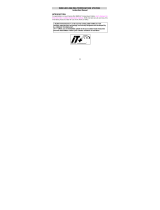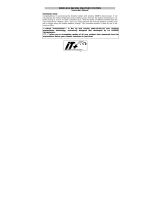La Crosse Technology WS6158-IT
The La Crosse Technology WS6158-IT is a weather wall clock that offers a range of features to help you stay informed about the weather conditions. With its wireless transmission capabilities, you can receive outdoor temperature readings from a remote transmitter, allowing you to monitor the temperature both inside and outside your home. Additionally, the weather forecasting feature provides you with an indication of upcoming weather conditions, helping you plan your day accordingly.
The WS6158-IT also includes an alarm function with a snooze option, so you can wake up on time and start your day refreshed. The large, easy-to-read LCD display shows the time, date, weekday, and both indoor and outdoor temperatures, giving you a quick and convenient overview of the current conditions.
La Crosse Technology WS6158-IT
The La Crosse Technology WS6158-IT is a weather wall clock that offers a range of features to help you stay informed about the weather conditions. With its wireless transmission capabilities, you can receive outdoor temperature readings from a remote transmitter, allowing you to monitor the temperature both inside and outside your home. Additionally, the weather forecasting feature provides you with an indication of upcoming weather conditions, helping you plan your day accordingly.
The WS6158-IT also includes an alarm function with a snooze option, so you can wake up on time and start your day refreshed. The large, easy-to-read LCD display shows the time, date, weekday, and both indoor and outdoor temperatures, giving you a quick and convenient overview of the current conditions.
















-
 1
1
-
 2
2
-
 3
3
-
 4
4
-
 5
5
-
 6
6
-
 7
7
-
 8
8
-
 9
9
-
 10
10
-
 11
11
-
 12
12
-
 13
13
-
 14
14
-
 15
15
-
 16
16
La Crosse Technology WS6158-IT Owner's manual
- Type
- Owner's manual
- This manual is also suitable for
La Crosse Technology WS6158-IT
The La Crosse Technology WS6158-IT is a weather wall clock that offers a range of features to help you stay informed about the weather conditions. With its wireless transmission capabilities, you can receive outdoor temperature readings from a remote transmitter, allowing you to monitor the temperature both inside and outside your home. Additionally, the weather forecasting feature provides you with an indication of upcoming weather conditions, helping you plan your day accordingly.
The WS6158-IT also includes an alarm function with a snooze option, so you can wake up on time and start your day refreshed. The large, easy-to-read LCD display shows the time, date, weekday, and both indoor and outdoor temperatures, giving you a quick and convenient overview of the current conditions.
Ask a question and I''ll find the answer in the document
Finding information in a document is now easier with AI
Related papers
-
La Crosse DCF-77 Owner's manual
-
 La Crosse Technology WS9632 Owner's manual
La Crosse Technology WS9632 Owner's manual
-
 La Crosse Technology WS9090 User manual
La Crosse Technology WS9090 User manual
-
 La Crosse Technology wireless weather station Owner's manual
La Crosse Technology wireless weather station Owner's manual
-
 La Crosse Technology WT280 Owner's manual
La Crosse Technology WT280 Owner's manual
-
 La Crosse Technology DCF-77 Owner's manual
La Crosse Technology DCF-77 Owner's manual
-
La Crosse Technology WS9132 User manual
-
 La Crosse Technology WS9611 User manual
La Crosse Technology WS9611 User manual
-
 La Crosse Technology WS9620 Owner's manual
La Crosse Technology WS9620 Owner's manual
-
La Crosse Technology wireless weather station User manual
Other documents
-
 Instant Transmission WS-9130 IT Owner's manual
Instant Transmission WS-9130 IT Owner's manual
-
TFA 35.1026.54.IT - Focus Funk Owner's manual
-
Technoline WT 188 User manual
-
Technoline WS 9140-IT User manual
-
Technoline Model User manual
-
Denver TRC-1490 Owner's manual
-
Technoline Model User manual
-
Technoline Model User manual
-
Technoline WT 189 User manual
-
Techno line Model Owner's manual























